Enjoyed Anne Ewbank’s article on the invention of the rice cooker.
Blog
Ditto intro
Another entry in the tedious series about my personal productivity tools.
Ditto is my transcription app. It’s a Python app using FastAPI for the web parts.
Overview
The goal with Ditto is to take scans (usually of journals) and make it easy to transcribe them a page at a time. Same idea as Unbindery, though scaled way, way down: single-user instead of crowdsourced, a simplified workflow, and it only supports one project at a time so I don’t spread my limited transcription time too thin. It looks like this:
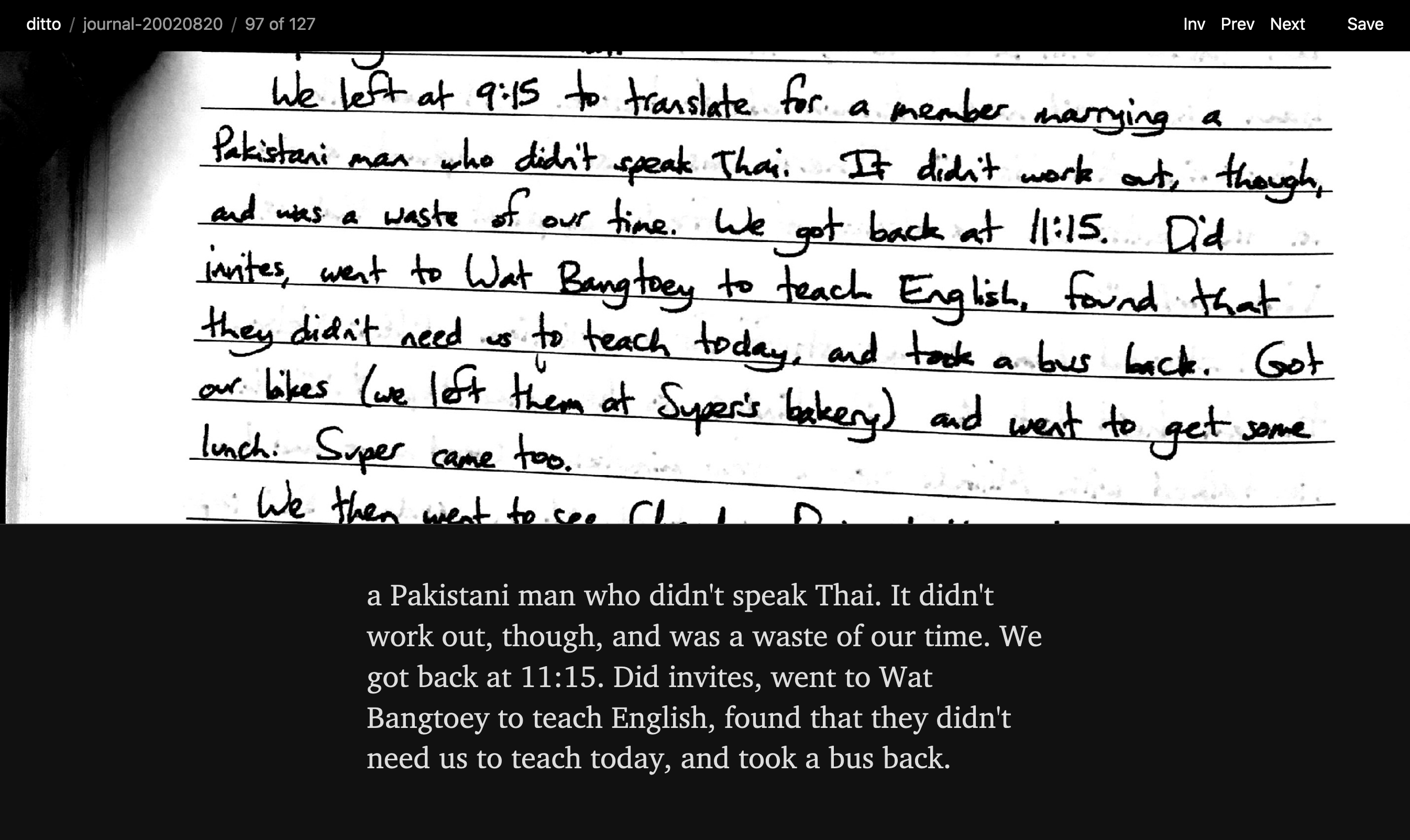
And there’s an inverted mode, which initially seemed like a great idea (dark mode, basically) but I never actually use it, I think because it’s harder to read:
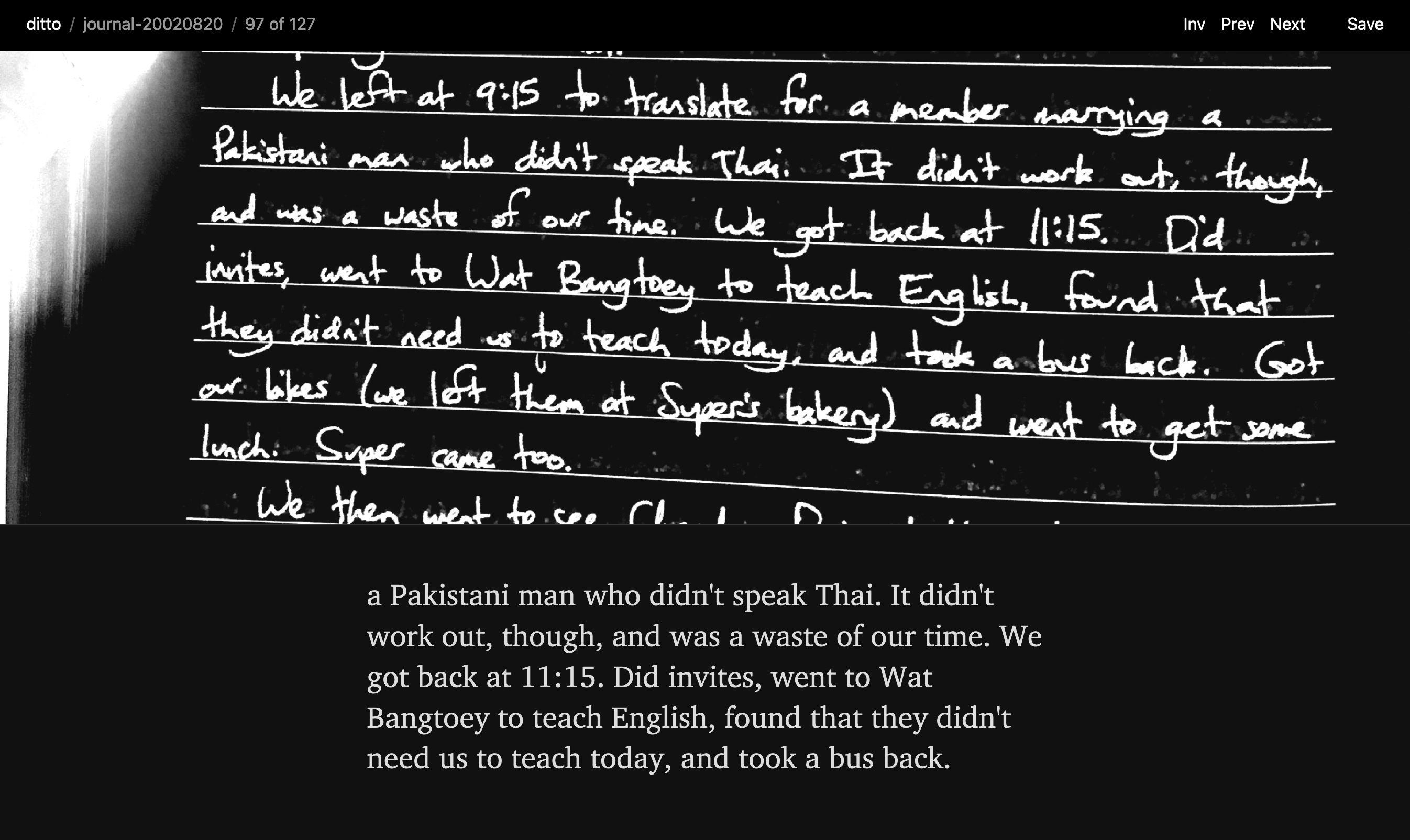
The transcriptions are stored as plain text files in the same directory as the corresponding images.
How I use Ditto
I spend a few minutes transcribing journals each morning as part of my daily routine. (As I finish each volume, I pull the transcribed text files off my server, concatenate them, do some minor formatting, and then import them into Vinci.)
The future
When I made Ditto, one of my goals was to make it work well on mobile so I could have a portable transcription station anywhere I went. It has a responsive design that does work on a phone, but the experience is currently slightly awkward (lots of panning), so I tend to only use it on my laptop. At some point I’d like to try to fix that.
Other than that, though, I’m happy with it. It works well. And it’s small — 340 lines of code. (Which makes me inordinately happy. Small tools are the best.)
Vinci intro
Another entry in the snore-inducing series talking about my personal productivity tools.
Vinci is my journal/log app, a private blog of sorts. It’s a Python app running in Django.
Overview
Vinci has notebooks which contain entries. Like most blogs, entries are displayed in reverse chronological order. It looks like this, except I usually write in English, har har:
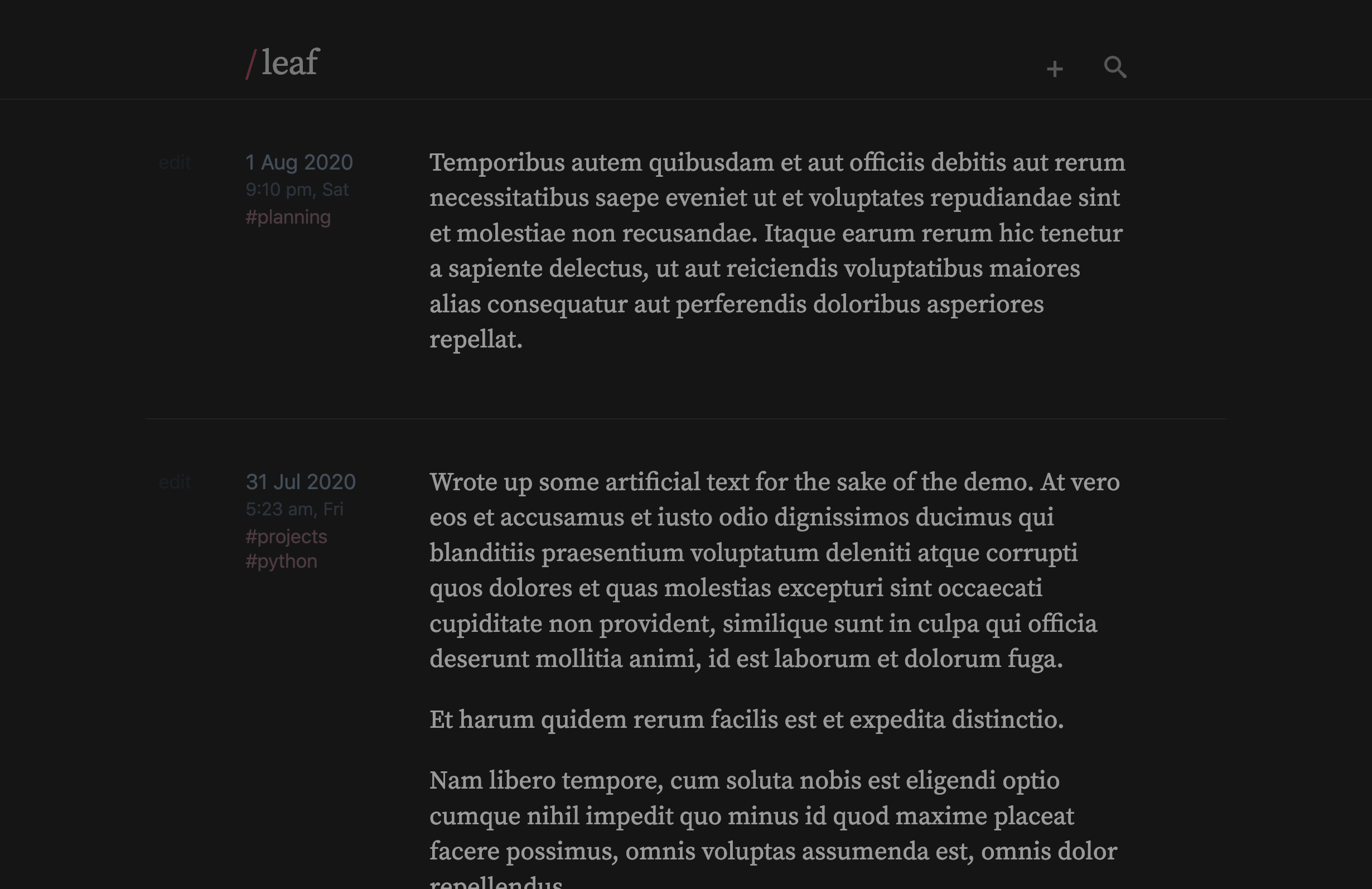
Editing an entry is a modal fullscreen panel, with the main textbox at top, the metadata textbox under that, and some controls at the bottom.
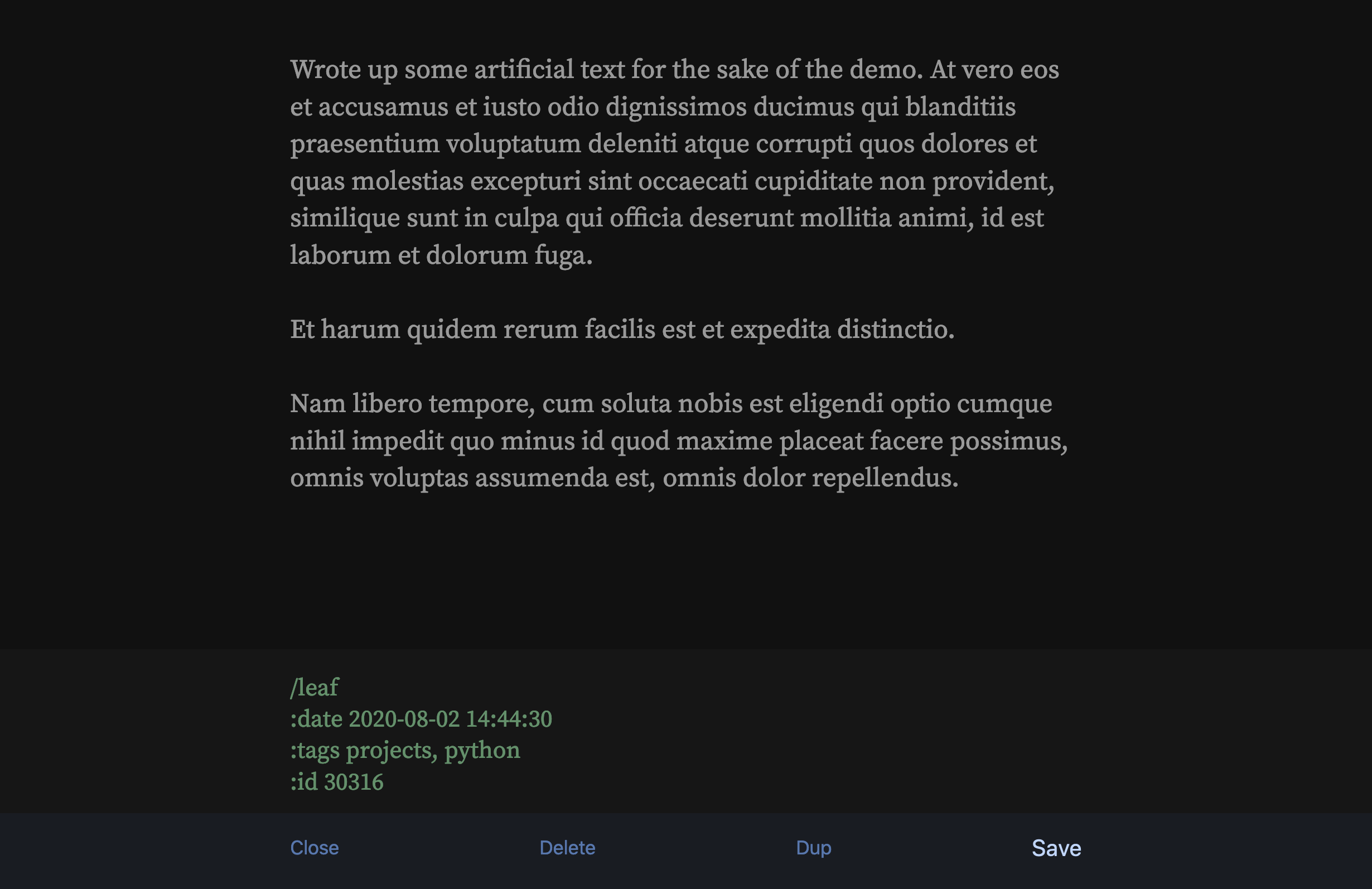
On save, Vinci splices the metadata and the text together and runs it through the payload processor.
Payload syntax
Vinci uses the text-based payload idea like Liszt. Its payload syntax looks like this:
/projects
:tags foo, bar
Worked on the [foo project](/leaf/3290) for a while. Ran into a few issues.
The first line is the notebook specifier. The second line (and this could have been anywhere, didn’t have to be at the top) has a command with some parameters. And the rest is Markdown.
There’s also a variant syntax where the first line can look like this: /projects/tag/tag2/tag3. I’ve started using that a little more often.
Because of how I like to write in my journal, I’ve also set up a special case for my /journal notebook, where adding an entry will either create a new entry for the day (if there isn’t one yet) or append to the existing entry, so there’s just one entry for each day. (I use Gate or Quill to jot down a paragraph and then append it quickly and easily.)
How I use Vinci
I use Vinci a lot. I maintain my personal journal in it, along with logs for most areas of my life — work, school, writing, projects, church, etc. Sometimes I create notebooks for specific projects, other times I use a higher-level notebook (like /projects) and use tags instead. At some point I’ll probably consolidate.
I have a /thinking notebook where once each morning I think through my current tasks/projects and write out what I need to do for each. Writing things down makes a world of difference for me, across the board.
Each morning I also spend a few minutes reading one of my past journal entries, as mentioned earlier today. (A while back I scanned all my paper journals and I’ve been slowly transcribing them — we’ll get to Ditto soon — and importing them into Vinci.) Lately I’ve been reading through my 2004 college entries. My undergraduate years were great, but I am very, very glad I’m not in that phase of life anymore.
Lastly, I reference these notebooks fairly frequently. (When did we replace our dishwasher, what did I last work on for that project I haven’t worked on in months, etc.)
The future
Vinci currently uses Whoosh for full-text indexing, but it’s unsupported and hasn’t been working as well for me lately. Several months ago I realized that if all my notebook entries are stored in plain text files, I can just use ripgrep or ag for fast and accurate searching, with the further benefit that in the event of my untimely demise, everything would be fairly easy for my family to copy out and preserve. (I really like plain text, can you tell?)
To that end, I started writing a new, smaller app in Go called Leaf. It’s going well, but I’m tempted to switch to FastAPI. Not sure yet if I will or not. (I’ve enjoyed learning Go and have used it on several small projects now, but I’m also thinking more about long-term maintenance across all these apps, and using a single stack would simplify things for me.)
I’m also thinking about adding a small CLI (in the web interface) that would make entry management easier — moving all entries with a specific tag to their own notebook, for example. Truth be told, I don’t know that entry management happens frequently enough to warrant a CLI, but I’m intrigued by the idea of putting a CLI in the interface, and if it goes as well as I hope it will, I see myself doing that in more of my tools. (Right now I see it as an extension of the search interface. Where right now I type dishwasher to search for that keyword, I’d eventually also be able to type something like :move /projects#cardiff /cardiff.)
As with Liszt, I’m also looking forward to moving to a lighter, simpler codebase. Vinci has a moderate amount of vestigial functionality that needs to go.
For the last year or so I’ve been rereading some of my old journals each day, to remind myself of my past. My memory tends to focus almost entirely on recent personal history — the last year or so — and if it weren’t for this ritual, I honestly don’t know that I would really ever think about my life before that, except for when my kids ask me stories about my childhood.
I’m learning some things about myself I’d completely forgotten about — apparently I was very interested in art right after my mission, for example, and even almost majored in it. (I’d thought I didn’t really get into art until ten years ago. Whoops.)
The other thing I’ve noticed is that the parts of my journal that mean the most to me now are the little bits about the other people in my life, friends and family, particularly those I don’t much interact with anymore and those who’ve passed on. It’s almost magical to me how fondness from the long ago past can be resurrected with a mere word or a phrase.
Two quick thoughts on reading:
Over the last few years I’ve wanted to get back into reading classics (“back into” referring to high school and college lit classes), but…it’s a struggle. I’ve DNFed pretty much all the classic novels I’ve tried to read — Oliver Twist, Madame Bovary, War & Peace, and Scaramouche, among others. What I suspect is probably at fault here: my fiction tastes skew heavily toward genre (primarily sf&f with occasional forays into mystery and thrillers), with realistic/literary fiction (basically all those aforementioned classics falling into this category) usually boring me out of my mind. Not entirely sure what to do about it yet, other than to try reading something like Dracula to see if the same thing happens.
Also, from the flip side of the coin: I’ve been reading a fair amount of more contemporary sf&f lately (the last several years) and goodness, there’s a lot of great fantasy and science fiction being published these days.
Recommended: Zeynep Tüfekçi’s article We Need to Talk About Ventilation from The Atlantic, on the importance of air flow in fighting Covid.
Liszt intro
First in the series introducing my personal productivity tools. Buckle up, this is going to be nerdy. And long.
Liszt is my to-do list app. Named after the composer, though I regret it a little since I butcher his name by pronouncing it lisht to differentiate it from the ordinary list. Heresy. The next version will have a better name, though. It’s a Python app running on Django.
Disclaimer: I don’t think this app is perfect. (Or any of the other tools I’ll talk about, for that matter.) I’ll describe things as they are, acknowledging here that there’s a lot of room for improvement.
Overview
This is what the dashboard looks like, populated with some dummy data:

And on mobile, where the controls move to the bottom for easier access:
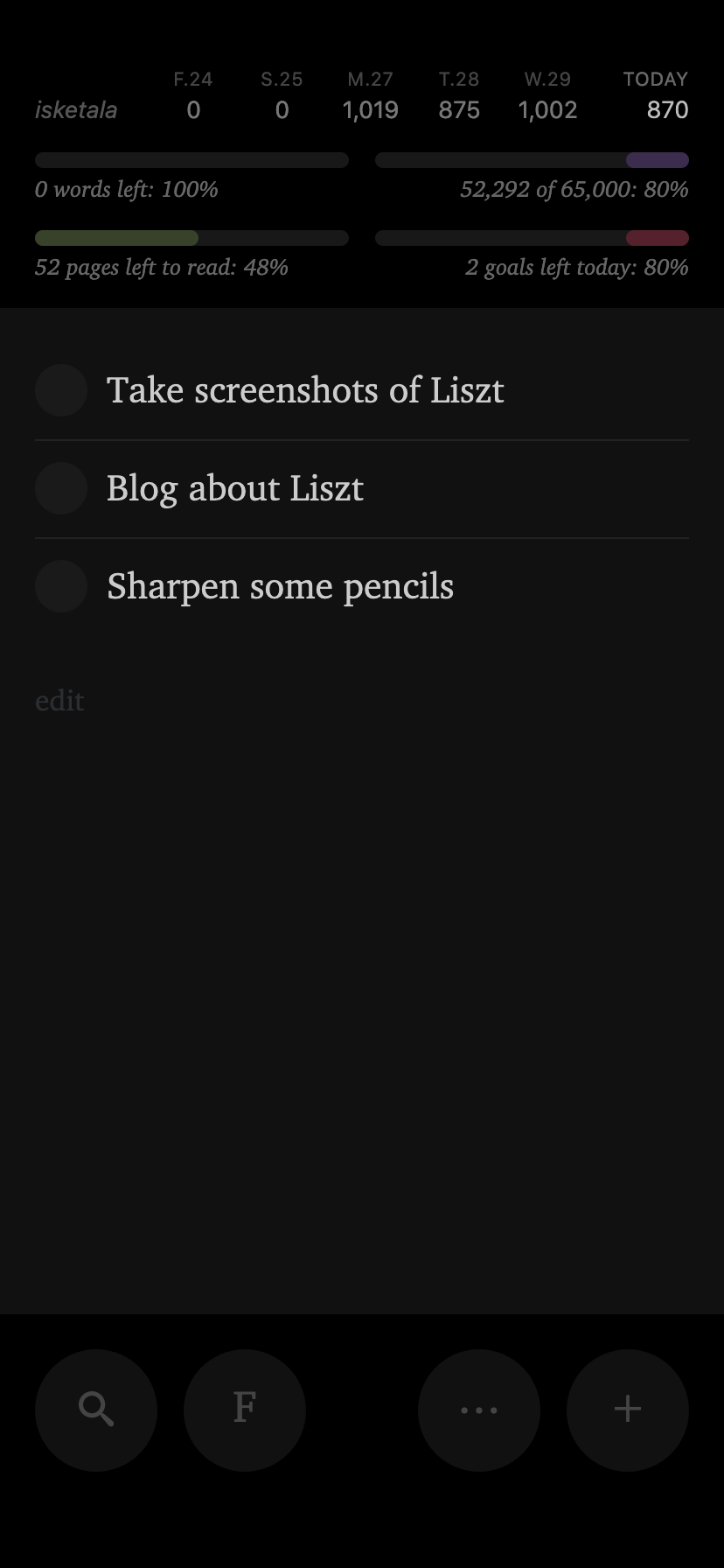
The top bit is my stats panel, with the data pulled in from my other tools’ APIs. Daily writing counts, daily words left, total words written on the novel (all three from Storybook), daily pages left (from Bookshelf), and daily goals left (from Momentum). I’ll cover those tools later.
There’s also a slide-in menu on the side, with my most commonly used top-level lists:

Double-clicking on a list item opens up an edit panel, which also allows me to move the item to another list with some commonly used lists included as buttons (this whole panel is kind of clunky and needs improvement):

Payload syntax
The basic idea behind Liszt (and this is common to many of my apps) is the text-based payload, which enables some nice cross-app integrations (more on this when I cover Gate and Quill). Adding items looks like this:
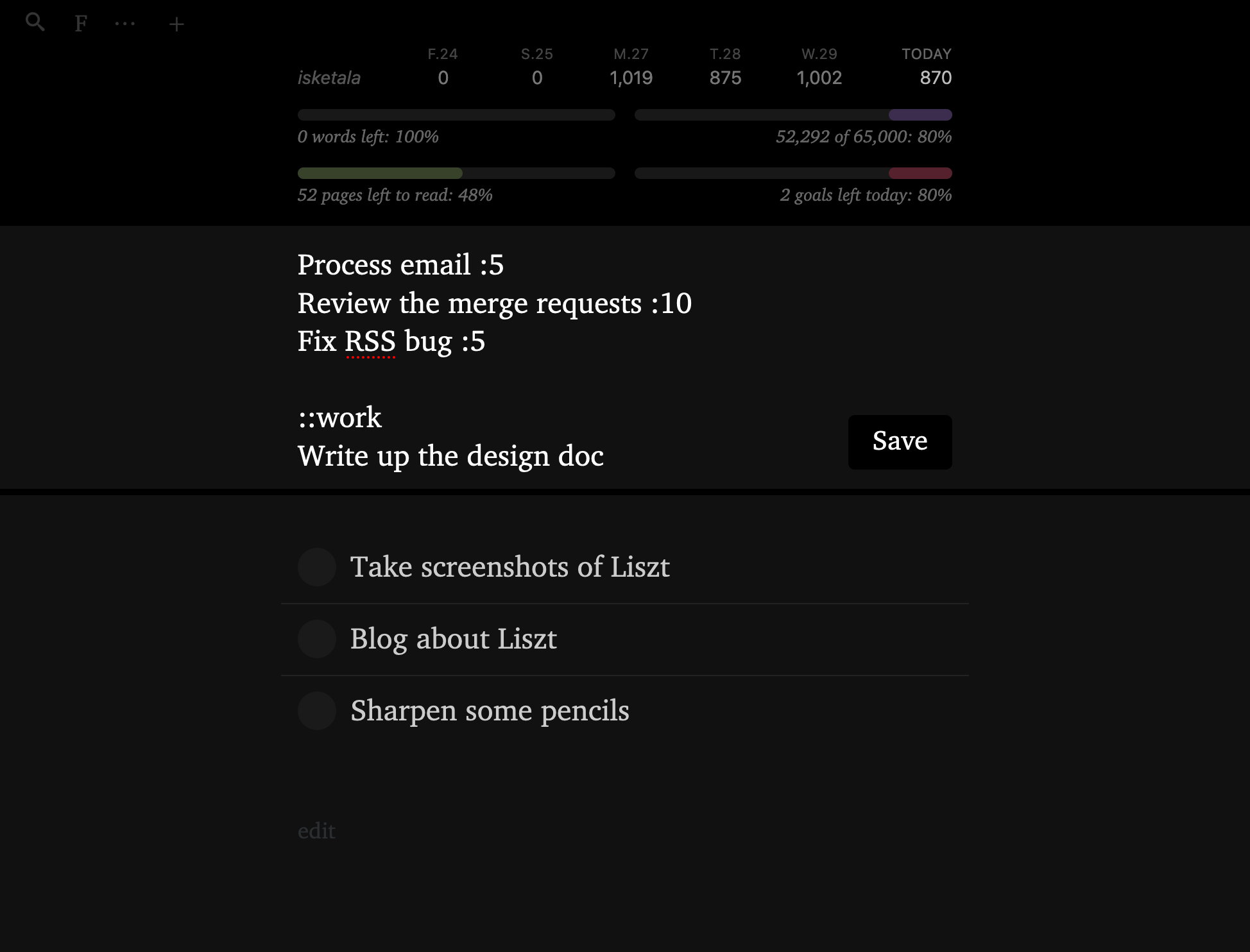
A Liszt payload (the text entered into the add tray) has one item per line, with optional blank lines and optional list specifiers. If there’s no specifier, it’ll assume the current list if there is one, otherwise it’ll default to ::inbox. (I use the double-colon prefix to mark lists, with a slash to specify sublists.) Here’s a fuller example of the syntax, again with dummy data:
Process email :5
Review the merge requests :10
::work/notifications
Read up on Python futures ::: https://docs.python.org/3/library/concurrent.futures.html
Refactor [::work/notifications/refactor]
Write up the design doc
The first two items (which have belt-mode durations, I’ll explain those in a minute) would go into the ::today list (which is the dashboard list). The last three items would go into the ::work/notifications list, as pictured here:
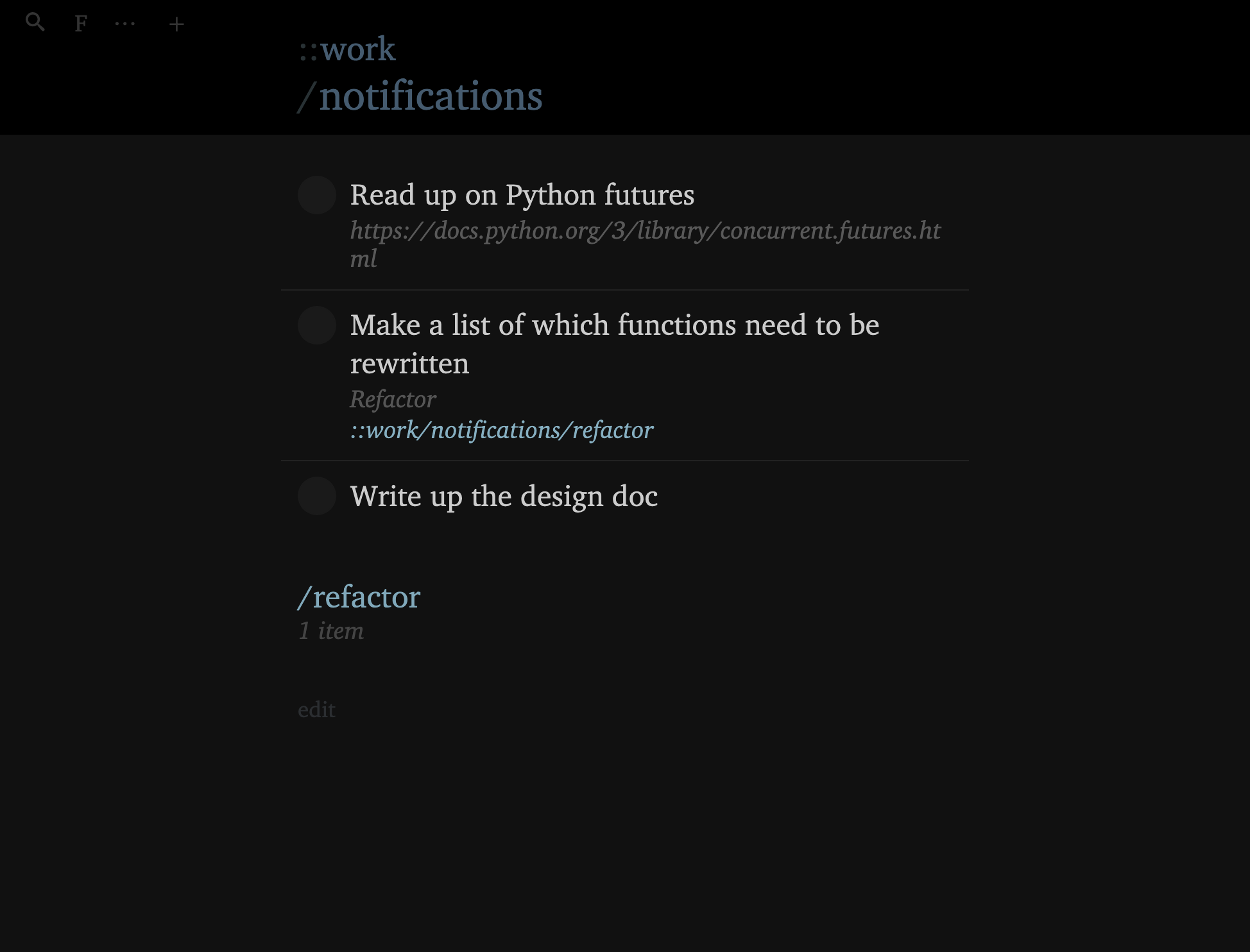
Of these, the first line sets a subtitle by putting it after the triple-colon marker. I use this all the time.
The second line is a symlink of sorts, pulling in the top item from the linked list (different meaning here) and showing it in place, with the Refactor text shown as the subtitle. I used to use this more often but haven’t as much lately.
You can also see that this list has a child list (::work/notifications/refactor).
Belt mode
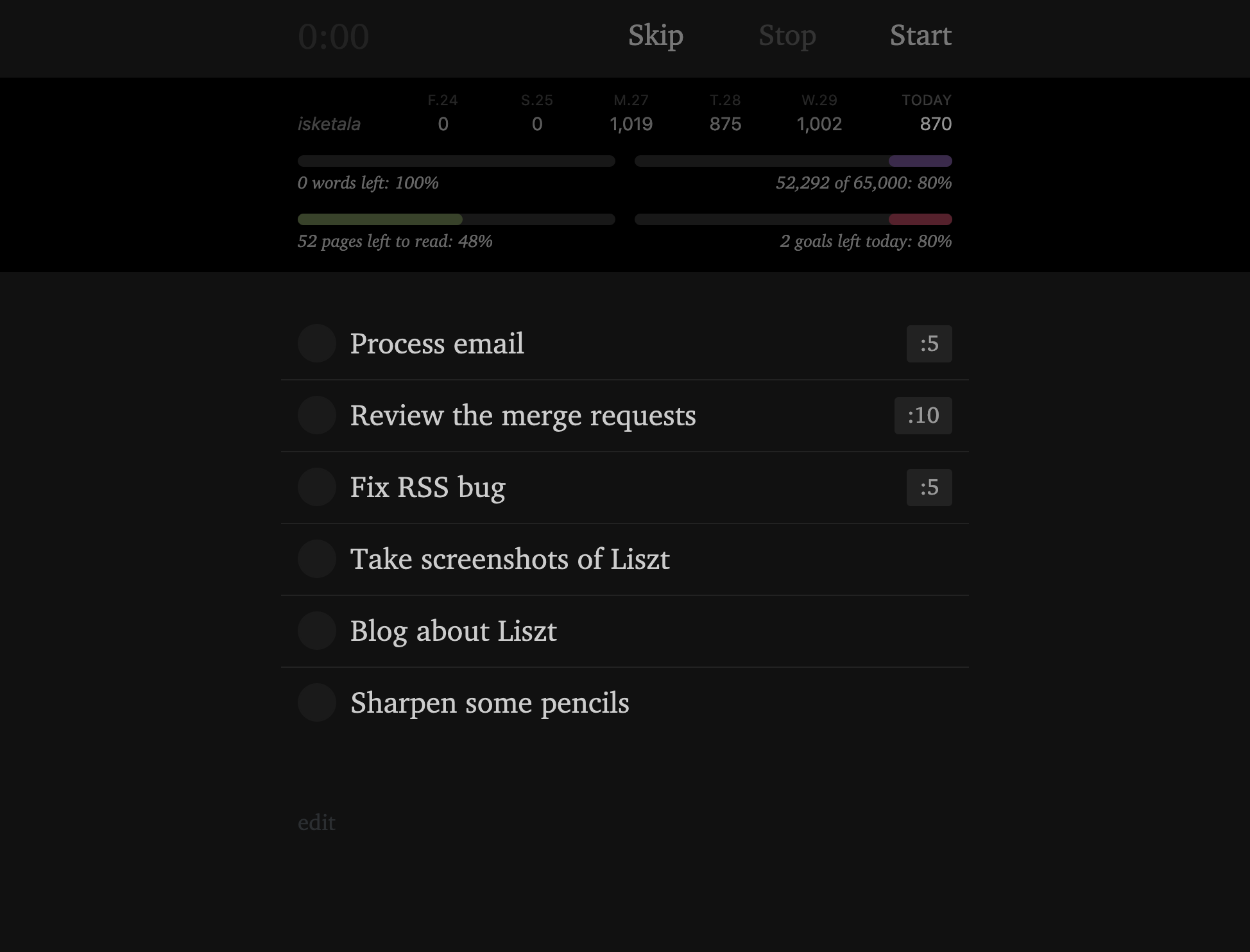
If an item has a duration marker included, that triggers belt mode (ala conveyer belts), as evidenced by the new bar at the top of the screen in the image above.
Brief backstory: I initially wrote an Electron app called Belt that did the same sort of thing, then a few months ago ported it to Go as a menubar app. Shortly after I finished that, I realized it would make much more sense in Liszt and brought the functionality in.
And what is that functionality? It’s just an easy way to time tasks from the list. When I hit Start, it switches into belt mode (also changing the favicon so I can tell that it’s running and turning on focus mode so I can only see the task I’m actively working on):
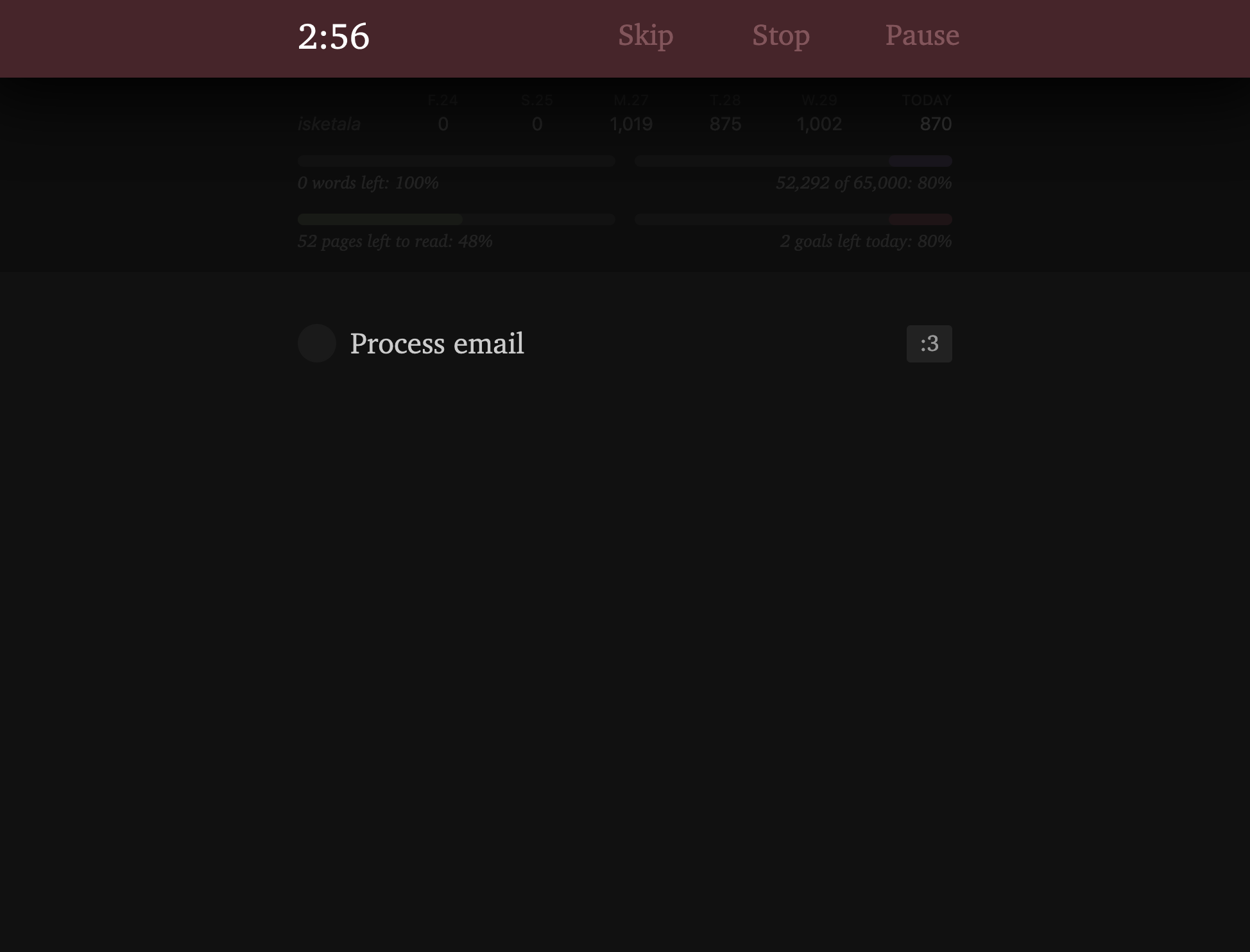
When the timer runs out, it plays a sound and brings up a panel allowing me to continue on to the next item in the list, stop belt mode, or add more time to the timer. (There are also keyboard shortcuts for all of this.)

How I use Liszt
On my laptop, I have Liszt open in Firefox as a pinned tab. On my phone, I have it saved to my homescreen as a PWA.
Every morning I go through the main lists and move the items I’m going to work on to the today list. I then work out of the today list the rest of the day, opening it often.
I use belt mode most days, primarily to help me stop avoiding tasks I don’t really want to work on (but that still need to be done).
The future
Lately I’ve grown enamored of the idea of storing data as plain text files in directories, rather than using an actual database like Postgres or Mongo. There are plenty of apps where this doesn’t make sense, but for personal, small tools, it works nicely, so I’m planning to migrate Liszt off SQLite to plain text, and I am very excited about it. Yes, I am that kind of a person.
While Django is fine (we use it at work and I love it), I’m planning to move to FastAPI, which I’m already using for Ditto and Arc. It’s a bit faster and feels more lightweight. I think in my mind I mostly use Django because of the ORM and admin; once I’ve given that up, the baby goes out with the bathwater.
I’m also looking forward to simplifying things, removing vestigial functionality, and sanding down as many of the friction points as I can.
Over the last several years I’ve built a number of personal productivity tools (almost all of them web apps) that I’ve never written about here. In the spirit of working in public, that’s about to change.
There are around fourteen twelve of them, though, so I’ll be spacing them out a little, with other posts interspersed here and there for the sake of our sanity. Also, while you’ll be hearing about them in a relatively short timeframe, remember that they weren’t written all at once, and that the older ones have been iterated on for a long time.
I generally won’t be releasing the source code, FYI. I still fiddle with these apps on the regular, and feeling an obligation to maintain stability for outside users would put a severe damper on that. Sorry. That said, the ideas are all free for the taking, and I’m happy to answer questions. (I feel I should lower the expectations here. These apps aren’t amazing or groundbreaking. Consider them small curiosities.)
I’ll have the first post in the series up soon.
Edit: Here they all are.
- Liszt — to-do list app
- Vinci — notebook app
- Ditto — transcription app
- Slash — blog engine
- Gate — quick entry app for my phone
- Quill — quick entry app for my laptop
- Momentum — daily goals app
- Bookshelf — reading tracking app
- Storybook — fiction writing app
- Saturn — launcher app
- Lector — reading app
- Arc — notes app
Lately I’ve felt a bit stuck with the minimalist religious art. Ideas aren’t coming as easily as they used to. Over the last month or so I’ve iterated on a lot of mockups that haven’t gone anywhere, and while that’s normal, usually there are more ideas that make it through.
I’ll keep plugging away at it, though — I feel reasonably confident that there are still many gospel concepts and stories that would work in this format. (And many more that wouldn’t. Some things seem impossible to abstract away into simple shapes.)
Another First Vision lecture! On Sunday night, Eric Jepson gave a lecture entitled Triangulating God as part of the Oakland Stake First Vision Lecture Series. He included First Vision VIII (at around 15:16), First Vision XIII (at around 34:08), and First Vision VI (at around 35:57). I haven’t watched the whole talk yet (same story, I know), but I’m looking forward to it.
